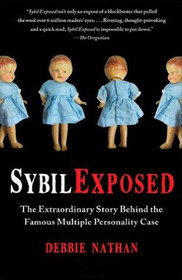Helpful Score: 2
The Extraordinary Story Behind
the Famous Multiple Personality Case
By Debbie Nathan
Sybil became popular, both in psychiatry and modern culture in the 1970s. Both the book and the movie made the complex disorder known as Multipersonality a phenomenon, though sensationalizing it, as well. Not only did it bring this disorder to the spotlight in mental health, it created a catchphrase and controversy, in spite of its horrific nature.
Psychiatry and psychology are not absolute, as the mind is a complex, hidden area. The memory is not always exact in time or place, being affected by many things. It deals with fact, feelings, and the shaded grey areas in between. The mind deals with the melding of both fact and feeling. Sometimes the mind remembers what the heart may have felt. History is recounted by what the mind remembers, sometimes losing things to interpretation, and sometimes colored by emotion, whether intentional or not.
For many years, the story of Sybil, as well as the ethics and motivations of her therapist have been questioned. This book is written by investigative reporters whose goal is to shed light on the truth of Sybils case, as well as the disorder.
Letters and documentation were supplied by the family of Sybil to researchers of what is now known as DID, Dissociative Identity Disorder. This disorder is still misunderstood and often misdiagnosed. The intent was to dispel myths, answering decades of questions and speculation.
Notes at the end of this fascinating book list the documents used and the resources that Debbie Nathan was privy to, in her writing of Sybil Exposed. I have no doubt that Sybil and her case will continue to be controversial, as will DID.
the Famous Multiple Personality Case
By Debbie Nathan
Sybil became popular, both in psychiatry and modern culture in the 1970s. Both the book and the movie made the complex disorder known as Multipersonality a phenomenon, though sensationalizing it, as well. Not only did it bring this disorder to the spotlight in mental health, it created a catchphrase and controversy, in spite of its horrific nature.
Psychiatry and psychology are not absolute, as the mind is a complex, hidden area. The memory is not always exact in time or place, being affected by many things. It deals with fact, feelings, and the shaded grey areas in between. The mind deals with the melding of both fact and feeling. Sometimes the mind remembers what the heart may have felt. History is recounted by what the mind remembers, sometimes losing things to interpretation, and sometimes colored by emotion, whether intentional or not.
For many years, the story of Sybil, as well as the ethics and motivations of her therapist have been questioned. This book is written by investigative reporters whose goal is to shed light on the truth of Sybils case, as well as the disorder.
Letters and documentation were supplied by the family of Sybil to researchers of what is now known as DID, Dissociative Identity Disorder. This disorder is still misunderstood and often misdiagnosed. The intent was to dispel myths, answering decades of questions and speculation.
Notes at the end of this fascinating book list the documents used and the resources that Debbie Nathan was privy to, in her writing of Sybil Exposed. I have no doubt that Sybil and her case will continue to be controversial, as will DID.




![header=[] body=[Get a free book credit right now by joining the club and listing 5 books you have and are willing to share with other members!] Help icon](/images/question.gif?v=52444873)
